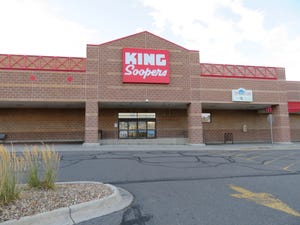Giant Eagle LEEDs the WayGiant Eagle LEEDs the Way
Giant Eagle, Pittsburgh, has made a habit of being an industry leader in garnering LEED certifications. The LEED (Leadership in Energy and Environmental Design) program was launched in 2000 by the U.S. Green Building Council, Washington, to recognize environmental building design and establish a common standard of measurement for defining a building. A building may be deemed Certified, Silver, Gold
December 1, 2008
LIZ PARKS
Giant Eagle, Pittsburgh, has made a habit of being an industry leader in garnering LEED certifications.
The LEED (Leadership in Energy and Environmental Design) program was launched in 2000 by the U.S. Green Building Council, Washington, to recognize environmental building design and establish a common standard of measurement for defining a “green” building. A building may be deemed Certified, Silver, Gold or Platinum in several categories (such as new construction and commercial interiors) based on the number of benchmarks it meets.
In December 2004, Giant Eagle opened a store in Brunswick, Ohio, that became the first Certified LEED supermarket in the world in the new construction category. Then in April 2007 a Pittsburgh Giant Eagle earned the first Silver LEED certification for a supermarket in the commercial interiors category.
A little more than two months ago, the chain achieved its highest level yet — and another industry first — receiving Gold LEED certification in the new construction category for a 75,000-square-foot supermarket in Columbus, Ohio, after an eight-month review.
Giant Eagle began its environmental learning process back in 1992, said Robert Garrity, the chain's senior vice president of sustainability, and chair of the Food Marketing Institute's Sustainability Task Force. That was when the chain created a Department of Energy Conservation, “long before being green was as popular as it is today,” he said.
In addition to LEED certifications, Giant Eagle has picked up a raft of Energy Star awards from the U.S. Environmental Protection Agency for adopting efficient energy practices in its stores, including a Sustained Excellence Award in 2006, 2007 and 2008 and Partner of the Year Award in 2004 and 2005.
Giant Eagle's goal, said Garrity, is not just to earn LEED or Energy Star recognition, but “simply to become more environmentally responsible.” While acknowledging it has been an honor to be the first in the industry to meet the stringent LEED requirements, Garrity stressed that it is even more important to Giant Eagle executives to experience the “learning curve” that occurs as they earn LEED certifications.
Garrity views LEED stores as “learning laboratories,” applying the knowledge gained to the next store built or refurbished. “We will not necessarily be looking for certification in all of our stores,” he said. “But we want to make sure that all the things that are logical for environmental purposes and energy design are being put into all our stores going forward.”
NEW APPROACHES
To earn Gold LEED certification for its Columbus store, Giant Eagle did “a variety of things that went beyond what we'd done before.” For example, the store is the first Giant Eagle outlet to sell, at its GetGo fuel stations, E-85 ethanol, a biofuel alternative to gasoline, despite the relatively small number of customers using ethanol fuel so far.
“Folks need to have energy-efficient vehicles,” Garrity said. “So while it's still a small base, we are seeing growth in ethanol sales, and we are hoping that as the demand for ethanol grows, people will think of us when they shop for fuel.”
For environmentally oriented employees, Giant Eagle installed not only a bike rack (as it did at its first LEED store in Brunswick, Ohio), but a changing room. “It's not a big thing,” said Garrity, “but it makes a difference in how we apply for LEED certification.”
Giant Eagle also decided to take its Columbus supermarket to “another level of efficiency” by putting in additional insulation in the construction of the building, as well as a white reflective roof (to reduce air conditioning loads), he said. The chain has also installed, for the first time, “clerestory” windows, a band of narrow windows along the very top of a wall.
Those windows, used in combination with 82 skylights, bring a considerable amount of natural light into the Columbus store. In addition to lower electricity usage, “there is an element of human nature that is attracted to outside lighting,” said Garrity. “It is both a comfort factor and an orientation factor. It gets us away from feeling like we are in a cave.”
The efficiencies in the store allow it to consume 20% less energy than comparable, conventionally designed supermarkets. Moreover, Giant Eagle is purchasing green power credits to offset all of the energy used at the store.
To fine-tune its energy management systems for maximum efficiency, Giant Eagle employed a third-party firm for a commissioning project. “In a supermarket, there are a wide variety of temperature zones, and you have all this air that is constantly moving, so having systems fine-tuned to control all that is extremely important,” Garrity said. “It means you are keeping your customers and team members comfortable in the most energy-efficient way possible.”
To ensure clean air in the store, Giant Eagle employs air quality sensors that constantly monitor carbon dioxide levels. Air quality is also abetted by the use of adhesives, sealants, paints, carpeting and wood products that are low in volatile organic compounds.
The store was constructed with an emphasis on sustainability: Nearly all wood used at the store was harvested from sustainable sources. Cabinetry contains no urea formaldehyde, while all gypsum wallboard is made from 10% recycled materials. The store uses no ozone-depleting refrigerants. Its water-saving faucets, urinals and toilets exceed the minimum requirements for LEED. A majority of the site's construction waste, such as steel and drywall, was recycled.
Even outside the store sustainable measures were taken: The parking lot's landscaping has been planted with drought-tolerant vegetation that requires no irrigation. A retention pond was installed to hold excess water, preventing storm water from flooding rivers and streams.
RECOUPING INVESTMENT
While the environmental enhancements that Giant Eagle has made in its LEED stores have created financial and operational savings for Giant Eagle, it “will take several years to recoup the capital investment,” Garrity acknowledged.
Energy systems and the recycling of cardboard and plastic were among the most economical steps taken initially. Giant Eagle has also been able to reduce some of the cost of doing business through initiatives that impact energy usage. “It can be as simple as not needing to replace plants or light bulbs as often,” he said.
Others steps like bike racks “have no direct benefit from a business standpoint, but indirectly make us more accessible to different modes of transportation, and hopefully that will result in more customers as well,” he said.
Moving forward, Giant Eagle is “actively incorporating the lessons we learned from LEED in our future stores on a routine basis,” Garrity said. “For instance, the energy systems, the skylights and much more are all standard now for new stores.” Clerestory windows and white roofing, among other LEED features, are also planned for new construction going forward. Three recently opened stores in the Columbus market all incorporate features from the LEED store.
Next year, two more new Giant Eagle stores will seek LEED certification.
About the Author
You May Also Like




